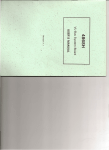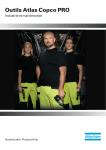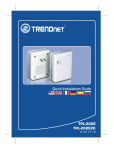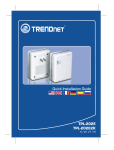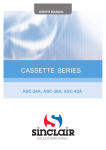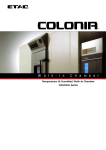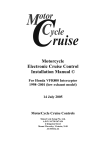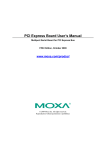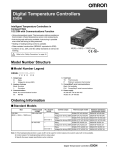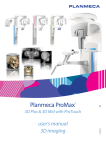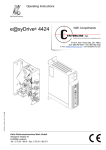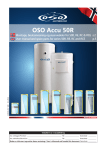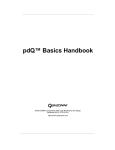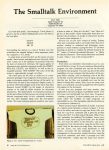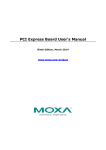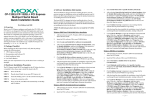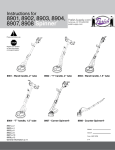Download Thermal Shock Chambers (TSA Series)
Transcript
Air to Air Thermal Shock Chambers TSA Series CAT.NO.E11138-Z1111 Energy savings and high reliability in the new series New series thermal shock chambers have been developed to improve our existing models, in terms of reliability, but also in terms of efficiency. Compared to the previous TSA series, the power consumption has been reduced of 35-50%. Energy saving is achieved thanks to the Eco operation mode; the instrumentation automatically adjusts pre-cooling and pre-heating periods and runs operations with just the necessary energy. Improvements in chamber’s reliability. Particular emphasis was placed on removing unnecessary loads and stresses from the refrigeration system, refrigerators themselves, and the refrigeration circuit. Various measures have been implemented to anticipate troubles and enhance chamber’s reliability. Thermal stress on the specimen can differ according to its position; therefore we have further minimized variations in the temperature attainment time that influences test results. Finally, we are accurately responding to the needs of these days by adapting our safety designs to global requirements, thanks to our experience of the market. TSA–72 1 TSA–102 TSA–202 TSA–302 * Equipped with options. 2 Characteristics Maximum 50% reduction in power consumption with Eco operation mode and new refrigerator control system ● Power consumption amount comparison example (Power consumption amount per cycle by comparing ESPEC chambers) –43% TSA−72ES−A The new series incorporates an algorithm that calculates the minimum operation time for pre-cooling and pre-heating by constantly measuring the amount of heat required for these processes in eco operation mode. This feature can further reduce power consumption and remove the inaccuracies and hassles caused by adjustments based on preliminar y experiments. Tests operation achieves both energy savings and reproducibility/ reliability. Previous model –40% TSA−102ES−W –35% TSA−202ES−W 0 5.0 10.0 15.0 Power consumption amount (kWh) 15.0 Power consumption amount (kWh) –50% TSA−72EH−W Previous model 0 5.0 10.0 Test conditions (Two-zone) High-temp. exposure : +125°C Low-temp. exposure : –40°C Specimen: Plastic molded ICs: 5 kg (72, 102) 10 kg (202) ● Temperature Parallel refrigerator control system for energy-saving control (Patent pending) Exposure time : 30 min. Temperature recovery time : Within 5 min. changes under Eco operation (example) Eco operation Normal operation Cold chamber Hot chamber Operation setup Stop operation Pre-heating operation High-temp. exposure Pre-heating Stop operation operation High-temp. exposure Test area temperature (option: power meter) (compared to previous chamber) 180 Test area temperature 140 80 60 40 Power (kW) 3 emperature (°C) 120 100 To optimize further the power consumption, the chamber features a parallel control system that connects two small refrigerators in parallel to the secondary side of the refrigeration circuit. The chamber can operate at the optimal refrigeration capacity based on the controlled temperature, by switching operation bet ween t wo refrigerators simultaneously or a single refrigerator. At stable low-temperature exposures, power consumption is also reduced by limiting refrigeration capacity with an electronic expansion valve. Measuring used power Low-temp. Low-temp. exposure exposure Stop operation Pre-cooling operation Stop operation Pre-cooling operation ● Parallel refrigerator control system power during Eco operation 160 Automatic setting of pre-cooling and pre-heating in energy saving, Eco operation mode (Patent pending) A wattmeter is provided as an option to measure the power consumed. It is also possible to halt a test by setting the stop time. This function is useful for saving energy. Characteristics Further reductions in power consumption with 500-hour continuous tests 1000 cycles continuous operation EH Type Test start 1000 cycles 24h 24h 24h Defrost 1h 24h Test time 20-hour reduction (Defrost 1 hour x 20 times) Power consumption amount 272 kWh reduction 1000 cycles Consumed power amount to defrost once : 13.6 kWh Consumed power amount to defrost (20 times) : 272 kWh (option: defrost-free operation) Defrost-free operation is provided as an option so 500-hour continuous operation can be performed without interruption (if test conditions are set for 15-minute exposure). Defrost 1h Defrost 1h Defrost 20 times Defrost 1h Until now testing was interrupted for defrosting when necessary, but ESPEC has developed a unique structure that stops frost formation under low temperatures by preventing the penetration of outside air (defrost-free operation [patent 3514735]). Defrosting during cycle tests is then unnecessary, thus reducing defrosting time and the power consumed for this operation. cycles (500-hour) test time comparison example Defrost operation (option: defrost-free operation) ● 1000 Defrost-free operation Minimizing defrosting burden with defrost-free operation Test conditions (Two-zone, No test halt) High-temp. exposure : +150°C 15 min. Low-temp. exposure : −65°C 15 min. Outside conditions : +23°C/60% rh Cooling water temp. : +25°C Specimen : No specimen Vertical sliding door Combination with the ESPEC’s evaluation system The ESPEC’s Conductor Resistance Evaluation System (sold separately) can continuously measure the minute resistance in solder joints and the conductive sections of connectors in low temperature and high temperature thermal cycle environments. It can be used connected to the thermal shock chamber. EH Type 1000 cycles Cable port ø50 mm 24h 24h 24h Defrost 1h Defrost 1h Defrost 1h Defrost 20 times Defrost 1h The chamber is equipped with a ø50 mm cable port so cables with bulky terminal connectors and plugs can be easily connected. A flat cable port is also available as an option. cycles (500-hour) test time comparison example Test start Defrost operation Equipped with a round cable port ● 1000 Vertically sliding door 24h Test time 20-hour reduction Defrost-free operation Equipped with a vertical sliding structure, the door does not disrupt when inserting and removing specimens or when connecting cables to a specimen. The door has been lightened so that it can be easily opened and closed. (Defrost 1 hour x 20 times) Power consumption amount 272 kWh reduction 1000 cycles Power consumed amount to defrost once : 13.6 kWh Power consumed amount to defrost (20 times) : 272 kWh Test conditions (Two-zone, No test halt) High-temp. exposure : +150°C 15 min. Low-temp. exposure : −65°C 15 min. Outside conditions : +23°C/60% rh Cooling water temp. : +25°C Specimen : No specimen Conductor Resistance Evaluation System connection (example) 4 Characteristics The pursuit of high performance, high accuracy, and ease of use. Highly accurate temperature recovery ● Recovery rate & temperature uniformity TSA−202ES−W measurement example +123°C ±1.0°C or lower 4.4 min. –38°C Test conditions High-temp. exposure: +125°C, 30 min. Pre-heating temperature: +145°C Low-temp. exposure: –40°C, 30 min. Pre-cooling temperature:– 55°C 7.3 min. ±1.5°C or lower Dampers with integrated rectifying function minimize variation in exposure conditions due to specimen position within the test area. This reduces the overall test time and shortens temperature recovery time, especially during low-temperature exposure. The uniformity in test conditions brought by this innovation also contributes to improved test reproducibility and reliability. Even more reliable tests (option: specimen temperature control*) Specimen: Printed circuit boards 150 pcs. Measuring points: 10 A single temperature sensor is attached to the specimen in the test area and the chamber is controlled by this temperature measurement. Even more accurate tests can be run by controlling the chamber with the specimen temperature because the air temperature and the temperature inside the specimen are different when attaining the temperature setting. The chamber is controlled so that the specimen temperature achieves the temperature setting even quicker and more accurately. * Cannot be combined with Eco operation mode. Specimen temperature monitoring (option: specimen temperature monitor with trigger function) Test area 5 Two temperature sensors are attached to the specimen in the test area to measure the specimen's temperature. This option features a trigger function that switches to the exposure test after the two temperatures reach the temperature setting, so even more precise thermal tests can be run. * Cannot be combined with Eco operation mode. Characteristics Improved reliability. Use our chambers safely and with peace of mind for many years to come. Global safety design ELV EV Drainage Evaporator Cascade condenser Inter. INJ To reduce thermal stress on the refrigerators and prevent corrosion in the circuit, the material and thickness of piping has been changed and this prevents refrigerant leaks. Th rough other cou ntless det ailed improvements, the reliability of the refrigeration circuit has been increased and it can be used safely for many years to come. ● Refrigeration circuit (Parallel refrigeration system: patent pending) Inter. INJ The newly developed refrigeration system improves the refrigeration circuit reliability Condenser Water Accumulator Compressor Accumulator Compressor Compressor We deliver chambers that conform to international safety standards. Our chambers conform to ISO risk assessment as well as global safety design electrical safety standards such as CE marking and EMC directive. · ISO 12100: 2010 · ISO 60204-1 · IEC 610000-6 *EN standardization is standardized by the European Union 6 Instrumentation Color LCD interactive touch-screen system Operation and settings simplified by the use of a touch-screen LCD display (instructions displayed on-screen). At-aglance confirmation of test patterns, test area temperatures, temperature cycles, upstream / downstream control, and trend graphs display. Enhanced test halt preset function (Patent pending) It is now possible to program tests to halt after cycle or exposure completion. Six cycle counters are also built-in to the instrumentation so a test halt preset can be programmed for each counter. The function can be used to multiple ends such as removing specimens to the chamber. ● Test settings ● Test detail monitor Test continuity selection function When the test is halted, select to resume the test from the point where it was halted or to start the test from the beginning. ● Halt preset function ● Service guide Setting Interactive key input by touch panel Display TFT Color LCD (10.4–inch) Temperature control function Setting resolution Temperature controls are PID control Temperature: 1°C Time: 1 min. (Remaining time display is 1 sec.) Input Thermocouple type T (copper/copper-nickel) Setting range Time: 0 to 99 hours 59 minutes Test cycle: 1 to 9999 cycles Test patterns RAM (freely register):40 patterns max. (Registration possible) ROM (built-in fixed): 20 standard test patterns Registered Auxiliary functions • Timer preset • Test continuity selection • Overheat/overcool protection • Up-stream/down-stream sensor selection • Stable time control • Exposure time reduction • Eco operation • Power failure recovery operation selection • Automatic defrost • Temperature recovery time setting • Pre-conditioning/ posttreatment • Dry operation ● Alarm 7 Test area: exposure temp. Hot chamber: pre-heating temp. Cold chamber: pre-cooling/defrosting temp. • Program memory • Automatic power shut-off • Programmed time display • Cycle counter • Test halt preset • Completion mode selection • Trend graph • Alarm history display • Sensor calibration • RS–485 communication • Accumulated time TEST STANDARD AND COMPATIBLE MODELS Exposure temperature Test standard High temp. Ambient temp. A +10 +85°C 0 +15 C +150°C 0 +15 D +200°C 0 Temperature Ambient recovery time Low temp. High/low temp. temp. Number of test cycles Model*1 Test starting point EL type ES type EH type — – 55°C 0 –10 B +15 +125°C 0 MIL–STD–883H (Method No. 1010.8) Exposure time — — 10 min. or longer — – 65°C 0 –10 E +15 +300°C 0 Worst case specimen Low temp. Minimum temp. or 10 Within High temp. 15 min. F +15 +175°C 0 +3 A +85°C 0 MIL–STD–202G (Method No. 107G) 0 –55°C –3 — — — — — — — — — — *2 *3 *2 *2 +3 B +125°C 0 Differs according to specimen weight — +5 C +200°C 0 +10 +25°C +5 –5 D +350°C 0 28 g or lower, 5 cycles Up–stream 15 min. or 30 min. Max 25 cycles Within Low temp. 50 cycles 28 g to 136 g, 30 min. 5 min. 5 min. 100 cycles 136 g to 1.36 kg, 60 min. 1.36 to 13.6 kg, 120 min. 13.6 to 136 kg, 240 min. — — — — — — — — 0 – 65°C –5 +5 E +500°C 0 +3 F +150°C 0 — +70°C ±2 +85°C ±2 +100°C ±2 IEC 60068–2–14 +125°C ±2 (JIS C 60068–2–14) +155°C ±2 +175°C ±2 +200°C ±2 — –5°C ±3 3 hrs. –10°C ±3 2 hrs. –25°C ±3 1 hrs. –40°C ±3 If not specified: –55°C ±3 3 hrs. –65°C ±3 JASO D 014–4 +65°C ±2 +70°C ±2 +80°C ±2 +85°C ±2 +90°C ±2 +100°C ±2 +110°C ±2 +120°C ±2 +125°C ±2 +130°C ±2 +140°C ±2 +150°C ±2 +155°C ±2 +160°C ±2 — –20°C ±3 –40°C ±3 EIAJ ED–2531A +60°C ±2 +65°C ±2 +70°C ±2 +75°C ±2 +80°C ±2 +85°C ±2 +90°C ±2 +95°C ±2 +100°C ±2 Ambient temp. 20 min. 40 min. 60 min. 90 min. 0°C ±3 –5°C ±3 –10°C ±3 –15°C ±3 3 hrs. –20°C ±3 2 hrs. –25°C ±3 1 hrs. –30°C ±3 If not specified: –35°C ±3 3 hrs. –40°C ±3 –45°C ±3 –50°C ±3 *2 — Exposure If not time specified within 10% 5 cycles Low temp. *2 *2 — Exposure If not time specified within 10% 5 cycles Low temp. *2 *2 2 to 3 min. Exposure 5 or time 10 cycles within 10% Low temp. *2 *3 *1 The test results may not meet specifications depending on the quantity of specimens or the setting method. *2 Some models cannot be used depending on test conditions. For further information, please contact ESPEC. *3 Applicable when equipped with the ambient-temperature exposure option. 8 CHAMBER AND UTILITY REQUIREMENTS EL type Power supply Model 42EL−A ES type 72EL−A 102EL−A 202EL−W 302EL−W 72ES−A Air-cooled Water-cooled EH type 72ES−W 102ES−W 202ES−W 72EH−W Air-cooled Water-cooled Water-cooled 200 VAC 49 A 70 A 70 A 110 A 120 A 78 A 120 A 112 A 220 VAC 47 A 70 A 70 A 110 A 120 A 75 A 120 A 108 A 380/400/415 VAC 27 A 45 A 45 A 65 A 70 A 50 A 70 A 60 A 0.4 to 0.7 MPa (4 to 7 kgf/cm2) Air 50 Hz — 95700 — 59700 95700 95700 60 Hz — 96100 — 64800 104600 96100 Cooling water supply rate (at reference water temp.+32°C)*1*2 — 4.6 m3 /h — 3.1 m3 /h Water pressure — 0.2 to 0.5 MPa (2 to 5 kgf/cm2) — Condensation load (KJ/h)*1 Piping connection size Outside dimensions mm (inch) 0.2 to 0.5 MPa (2 to 5 kgf/cm2) 32 A W 1140 H 1900 D 1270 W 1310 H 1900 D 1470 *1 Maximum possible value during temperature recovery. *2 Rate depends on the cleanliness of the heat exchanger. 9 4.6 m3 /h W 1550 H 1900 D 1470 W 1550 H 1900 D 1770 W 1870 H 1900 D 1770 W 1310 H 1900 D 1470 W 1550 H 1900 D 1470 W 1550 H 1900 D 1770 W 1310 H 1900 D 1770 EL Type Model TSA–42EL–A TSA–72EL–A Cold chamber Hot chamber Test area Temp. recovery Performance*1 System High temp. exposure range*2 TSA–302EL–W –65 to 0°C (–85 to +32°F) Temp. fluctuation*3 ±0.5°C (±0.9°F) Pre-heat upper limit +205°C (+401°F) Temp. heat up time*4 Within 10 min. Ambient temp. to +200°C (+392°F) Within 15 min. Within 70 min. Ambient temp. to –70°C (–94°F) Within 40 min. Within 60 min. Within 70 min. Pre-cool lower limit Temp. pull down time*4 –75°C (–103°F) Within 40 min. Two-zone: High temp. exposure: +125°C 30 min. Low temp. exposure: –40°C 30 min. Power supply voltage: Rated voltage Sensor position: Upstream Recovery conditions Temp. recovery time*5 Specimen 3.5 kg Specimen 6.5 kg Specimen 7.5 kg Specimen 16 kg Specimen 17 kg (Plastic molded ICs, 2.5 kg, (Plastic molded ICs, 5 kg, (Plastic molded ICs, 5 kg, (Plastic molded ICs, 10 kg, (Plastic molded ICs, 10 kg, specimen basket/brackets 1 kg) specimen basket/brackets 1.5 kg) specimen basket/brackets 2.5 kg) specimen basket/brackets 6 kg) specimen basket/brackets 7 kg) Within 15 min. Within 5 min. Within 10 min. Cold-rolled rust proof treated steel plate (melamine resin coating) Interior material Stainless steel plate Insulation Glass wool, rigid polyurethane foam Door Manually operated sliding door with unlock button Heater Refrigeration unit TSA–202EL–W Ambient temp. +50 to +200°C (+122 to +392°F) Low temp. exposure range Exterior material Construction TSA–102EL–A Two-zone test by means of damper switching Stripped wire heater Mechanical cascade refrigeration system System Air-cooled condenser Hermetically sealed rotary compressor Compressor Hermetically sealed scroll compressor Expansion mechanism Electronic expansion valve, other High temp. side: R404A Low temp. side: R508A Refrigerant Water-cooled condenser High temp. side: R404A Low temp. side: R23 Cooler Plate fin cooler, cold accumulator Air circulator Sirocco fan Damper driving unit Air cylinder Test area load resistance 30 kg (Equally distributed load) 50 kg (Equally distributed load) 240 x 460 x 370 410 x 460 x 370 650 x 460 x 370 650 x 460 x 670 970 x 460 x 670 Inside dimensions (W x H x D mm/in.) (9.45 x 18.11 x 14.57) (16.14 x 18.11 x 14.57) (25.59 x 18.11 x 14.57) (25.59 x 18.11 x 26.38) (38.19 x 18.11 x 26.38) 1140 x 1900 x 1270 1310 x 1900 x 1470 1550 x 1900 x 1470 1550 x 1900 x 1770 1870 x 1900 x 1770 Outside dimensions (W x H x D mm/in.) *6 (44.88 x 74.80 x 50) (51.57 x 74.80 x 57.87) (61.02 x 74.80 x 57.87) (61.02 x 74.80 x 69.69) (73.62 x 74.80 x 69.69) Weight Approx. 730 kg Approx. 900 kg 49 A 70 A Allowable ambient conditions Utility requirements 200 VAC 3ø 50/60 Hz Power supply Approx. 1050 kg Approx. 1200 kg Approx. 1420 kg 0 to 40°C (+32 to +104°F) 70 A 110 A 120 A 120 A 220 VAC 3ø 60 Hz 47 A 70 A 70 A 110 A 380/400/415 VAC 3ø 50 Hz 27 A 45 A 45 A 65 A 70 A 62 dB 65 dB Noise level*7 65 dB Air supply 0.4 to 0.7 MPa (4 to 7 kgf/cm2) Cooling water supply pressure Cooling water supply rate*8 Operating cooling water temp. range *1 Air-cooled: Ambient temperature of +23°C Water-cooled: Ambient temperature of +10 to +30°C and a cooling water temperature of +25°C *2 If the high-temperature exposure range lower limit +60°C is required, select the “ambient-temperature exposure” option *3 Performance shown above conforms to IEC 60068-3-5: 2001 *4 Temperature heat-up/pull-down time are applicable only during independent chamber operation — 0.2 to 0.5 MPa (2 to 5 kgf/cm2) — 4.6 m3 /h (ref. water temp.: +32°C) — +5 to +38°C (+41 to +100°F) *5 Tolerance in temperature recovery time is based on IEC60068-2-1 and IEC60068-2-2 *6 Excluding protrusions *7 Noise level was measured in an anechoic room at a height of 1.2 m from the floor and a distance of 1 m from the chamber front panel (ISO 1996-1:2003 A-weighted sound pressure level). Actual noise emissions may increase because of surrounding reverberations in the place of installation, therefore use caution in selecting a place of use. *8 Rate depends on the cleanliness of the heat exchanger 10 ES Type Model TSA–72ES–A/W Cold chamber Hot chamber Test area Temp. recovery Performance*1 System TSA–102ES–W High temp. exposure range +60 to +200°C (+140 to +392°F) Low temp. exposure range –70 to 0°C (–94 to +32°F) ±0.5°C (±0.9°F) Temp. fluctuation*2 Pre-heat upper limit +205°C (+401°F) Temp. heat up time*3 Ambient temp. to +200°C (+392°F) within 15 min. Pre-cool lower limit Temp. pull down time*3 Recovery conditions –75°C (–103°F) Ambient temp. to –75°C (–103°F) Within 50 min. Within 40 min. Within 45 min. · Three-zone High-temp. exposure: · Three-zone +150°C, 30 min. High-temp. exposure: +150°C, 30 min. Ambient-temperature exposure: Ambient-temperature exposure: Ambient temperature, 5 min. Ambient temperature, 10 min. Low-temp. exposure: –65°C, 30 min. Low-temp. exposure: · Power supply voltage: Rated voltage –65°C, 30 min. · Sensor position: Upstream · Power supply voltage: Rated voltage · Sensor position: Upstream · Specimen 6.5 kg · Specimen 7.5 kg · Specimen 26 kg Plastic molded ICs: 5 kg Plastic molded ICs: 5 kg Plastic molded ICs: 20 kg Specimen basket/brackets: 1.5 kg Specimen basket/brackets: 2.5 kg Specimen basket/brackets: 6 kg Temp. recovery time*4 Within 5 min. Exterior material Stainless steel plate Insulation Glass wool/rigid polyurethane foam Door Manually operated sliding door with unlock button Heater Refrigeration unit Within 10 min. Cold rolled rust proof treated steel plate (melamine resin coating) Interior material Construction TSA–202ES–W Two-zone or three-zone test by means of damper switching Stripped wire heater Mechanical cascade refrigeration system System Air-cooled condenser or water-cooled condenser Compressor Water-cooled condenser Hermetically sealed scroll compressor Expansion mechanism Electronic expansion valve, other Refrigerant High temp. side: R404A Low temp. side: R23 Cooler Plate fin cooler, cold accumulator Air circulator Sirocco fan Damper driving unit Air cylinder Test area load resistance Inside dimensions (W x H x D mm/in.) 30 kg (Equally distributed load) 410 x 460 x 370 (16.14 x 18.11 x 14.57) 50 kg (Equally distributed load) 650 x 460 x 370 (25.59 x 18.11 x 14.57) 650 x 460 x 670 (25.59 x 18.11 x 26.38) Outside dimensions (W x H x D mm/in.) *5 1310 x 1900 x 1470 (51.57 x 74.80 x 57.87) 1550 x 1900 x 1470 (61.02 x 74.80 x 57.87) 1550 x 1900 x 1770 (61.02 x 74.80 x 69.69) Weight Approx. 1050 kg Approx. 1150 kg Utility requirements Allowable ambient conditions Power supply 200 VAC 3ø 50/60 Hz 78 A 120 A 220 VAC 3ø 60 Hz 75 A 120 A 380/400/415 VAC 3ø 50 Hz 50 A 70 A 65 dB or lower Noise level*6 0.4 to 0.7 MPa (4 to 7 kgf/cm2) Air supply Cooling water supply pressure Cooling water supply rate*7 Operating cooling water temp. range 0.2 to 0.5 MPa (2 to 5 kgf/cm2) (water-cooled specification) 3.1 m3 /h 0.2 to 0.5 MPa (2 to 5 kgf/cm2) (reference water temp: +32°C) (water-cooled specification) 4.6 m3 /h (reference water temp: +32°C) +5 to +38°C (water-cooled specification) *1 Ambient temperature of +23°C and a cooling water temperature of +25°C *2 Performance shown above conforms to IEC 60068-3-5: 2001 *3 Temperature heat-up/pull-down time are applicable only during independent chamber operation *4 Tolerance in temperature recovery time based on IEC60068-2-1 and IEC60068-2-2 *5 Excluding protrusions 11 Approx. 1400 kg 0 to +40°C (+32 to +104°F) *6 Noise level was measured in an anechoic room at a height of 1.2 m from the floor and a distance of 1 m from the chamber front panel (ISO 1996-1:2003 A-weighted sound pressure level). Actual noise emissions may increase because of surrounding reverberations in the place of installation, therefore use caution in selecting a place of use. *7 Rate depends on the cleanliness of the heat exchanger EH Type Two-zone or three-zone test by means of damper switching Temp. recovery Cold chamber Hot chamber Test area TSA–72EH–W System Performance*1 Model High temp. exposure range*2 +60 to +200°C (+140 to +392°F) Low temp. exposure range –70 to 0°C (–94 to +32°F) ±0.5°C (±0.9°F) Temp. fluctuation*3 Pre-heat upper limit +205°C (+401°F) Temp. heat up time*4 Ambient temp. to +200°C (+392°F) within 15 min. Pre-cool lower limit Temp. pull down time*4 Recovery conditions –77°C (–106.6°F) Ambient temp. to –75°C (–103°F) within 50 min. · Two-zone High-temp. exposure: +150°C, 15 min. Low-temp. exposure: –65°C, 15 min. · Power supply voltage: Rated voltage · Sensor position: Downstream · Specimen 5 kg Plastic molded ICs: 3.5 kg Specimen basket/brackets: 1.5 kg Temp. recovery time*5 Within 5 min. Exterior material Cold rolled rust proof treated steel plate (melamine resin coating) Interior material Stainless steel plate Insulation Glass wool/rigid polyurethane foam Manually operated sliding door with unlock button Heater Refrigeration unit Construction Door Stripped wire heater Mechanical cascade refrigeration system Water-cooled condenser System Compressor Hermetically sealed scroll compressor Expansion mechanism Refrigerant Electronic expansion valve, other High temp. side: R404A Low temp. side: R23 Cooler Plate fin cooler, cold accumulator Air circulator Sirocco fan Damper driving unit Air cylinder Test area load resistance 30 kg (Equally distributed load) Inside dimensions (W x H x D mm/in.) 410 x 460 x 370 (16.14 x 18.11 x 14.57) Outside dimensions (W x H x D mm/in.) *6 1310 x 1900 x 1770 (51.57 x 74.80 x 69.68) Weight Approx. 1150 kg Utility requirements Allowable ambient conditions Power supply 0 to +40°C (+32 to +104°F) 200 VAC 3ø 50/60 Hz 112 A 220 VAC 3ø 60 Hz 108 A 380/400/415 VAC 3ø 50 Hz 60 A 65 dB or lower Noise level*7 0.4 to 0.7 MPa (4 to 7 kgf/cm2) Air supply 0.2 to 0.5 MPa (2 to 5 kgf/cm2) Cooling water supply pressure Cooling water supply rate*8 4.6 m3 /h (reference water temp: +32°C) Operating cooling water temp. range *1 Ambient temperature of +23°C and a cooling water temperature of +25°C *2 During pre-heating, prevention operation for temperature heat-up may be worked. *3 Performance shown above conforms to IEC 60068-3-5: 2001 *4 Temperature heat-up/pull-down time are applicable only during independent chamber operation *5 Tolerance in temperature recovery time based on IEC60068-2-1 and IEC60068-2-2 *6 Excluding protrusions +5 to +38°C *7 Noise level was measured in an anechoic room at a height of 1.2 m from the floor and a distance of 1 m from the chamber front panel (ISO 1996-1:2003 A-weighted sound pressure level). Actual noise emissions may increase because of surrounding reverberations in the place of installation, therefore use caution in selecting a place of use. *8 Rate depends on the cleanliness of the heat exchanger 12 SAFETY DEVICES • Leakage breaker (200, 220V AC specifications) MODEL TSA – • Circuit breaker (380, 400/415V AC CE specifications) Condensation system A : Air-cooled type W : Water-cooled type • Electrical compartment door switch • Test area door switch • Hot chamber overheat protection switch Performance classification EL ES EH • Cold chamber overheat protection switch • Hot chamber overheat protector (controller) • Cold chamber overheat protector (controller) Test area capacity 42 : 40L 72 : 70L 102 : 110L 202 : 200L 302 : 300L • Air circulator overload relay • Refrigerator high/low pressure switches • Compressor built-in protector (except TSA–42EL) • Compressor temperature switch • Thermal relay for compressor (TSA–42EL only) • Water suspension relay (water-cooled specification only) • Air circulator thermal relay ACCESSORIES • Motor reverse prevention relay • Specimen basket (18-8 Cr-Ni stainless steel/5 mesh metal basket) • Air pressure switch TSA–42 (W230 x H40 x D356 mm/load capacity 2.5 kg) ······················ 2 • Fuse • Cooling tower interlock terminal (water-cooled specification only) • Compressor circuit breaker • Heater circuit breaker • Test area overheat/overcool protector (controller) • Test area overheat/overcool protector (option) • Air purge valve • Specimen power supply control terminal TSA–72 (W400 x H40 x D356 mm/load capacity 5 kg) ························· 2 TSA–102 (W640 x H40 x D356 mm/load capacity 5 kg) ························· 2 TSA–202 (W640 x H40 x D656 mm/load capacity 17 kg) ······················· 2 TSA–302 (W960 x H40 x D656 mm/load capacity 17 kg) ······················· 2 FITTINGS • Cable port ø50 mm (left side) ·················································· 1 • Specimen power supply control terminal ································ 1 • Time signals ············································································· 2 • Shelf brackets (shelf attachment pitch 60 mm, adjustable in 7 levels) ···· 2 sets • Cartridge fuse DANGER ● Do not use explosive substances, flammable substances, or substances that contain those substances as a specimen under any circumstances. Danger: Risk of explosion and fire. ● Do not put corrosive substances inside the test area. If corrosive substances are generated from the specimen, the life of the product's corrosion resistance will decrease dramatically due, in particular, to corrosion of stainless steel, resin, and silicone. ● Do not use living organisms or items that exceed the allowable heat load as a specimen. CAUTION 13 Always read the user's manual before using the product. 5A ···························································································· 2 10A (non-standard specification) · ·········································· 1 • Cable port rubber plug ····························································· 1 • Nipple (water-cooled specification only) ·································· 1 • Strainer (water-cooled specification only) ······························· 1 • Strainer element (water-cooled specification only) ················· 1 • User’s manual · ········································································· 1 DIMENSIONS (Unit: mm) TSA−72EL · 72ES 580 410 495 880 550 135 370 1900 460 1470 560 235 1310 TSA−202EL · 202ES 820 650 495 850 135 880 670 1900 460 1770 560 235 1550 14 1000 cycles Consumed power amount to defrost once : 13.6 kWh Consumed power amount to defrost (20 times) : 272 kWh Test conditions (Two-zone, No test halt) High-temp. exposure : +150°C 15 min. Low-temp. exposure : −65°C 15 min. Outside conditions : +23°C/60% rh Cooling water temp. : +25°C Specimen : No specimen OPTIONS Defrost-free operation ● 1000 cycles (500-hour) test time comparison example EH Type Test start 1000 cycles 24h 24h 24h Defrost 1h Defrost 1h Defrost 1h Defrost 1h Defrost operation Defrost 20 times 24h Test time 20-hour reduction Defrost-free operation For two-zone tests, enables continuous tests without requiring defrosting for up to 500 hours max. ESPEC has developed a unique structure (patent: 3514735) that prevents the penetration of outside air and uses recirculated air during testing to stop frosting on the low-temperature side. This enables continuous tests up to 500 hours, so around 20 defrost cycles during this period can be eliminated. This option can reduce both the test time in the amount of the defrosting time (approx. 60 minutes each time) and the power consumption required for def rosting (13.6 kWh each time). (Defrost 1 hour x 20 times) Power consumption amount 272 kWh reduction 1000 cycles Power consumed amount to defrost once : 13.6 kWh Power consumed amount to defrost (20 times) : 272 kWh Test conditions (Two-zone, No test halt) High-temp. exposure : +150°C 15 min. Low-temp. exposure : −65°C 15 min. Outside conditions : +23°C/60% rh Model Number of cycles * The TSA−42EL−A, 72EL−A and 102EL−A have a 300-mm protrusion on the top. Temp. recovery time 15 TSATSATSA-302EL TSA-72EH 102EL, ES 202EL, ES Maximum 1000 cycles Maximum 500 cycles (Maximum 500-hour) (Maximum 500-hour) TSA-42EL TSA72EL, ES High-temp. exposure/ time Low-temp. exposure/ time Outside conditions Cooling water temp. Power supply voltage Sensor position Specimen Cooling water temp. : +25°C Specimen : No specimen +125°C/30 min. +150°C/ 15 min. −40°C/30 min. −65°C/ 15 min. +23°C/60% rh +25°C Rated voltage Downstream of specimen 1.5 kg Plastic molded ICs 1.0 kg Specimen basket/shelf brackets 0.5 kg ( ) ( Within 15 min. 5.0 kg Plastic molded ICs 3.5 kg Specimen basket/ shelf brackets 1.5 kg 10.0 kg Plastic molded ICs 7 kg Specimen basket/ shelf brackets 3 kg ) ( Within 5 min. Within 10 min. ) 5.0 kg Plastic molded ICs 3.5 kg Specimen basket/shelf brackets 1.5 kg ( ) Within 5 min. OPTIONS Specimen temperature control ● Measurement A sensor is attached to the specimen to control the chamber based on the specimen temperature. The specimen temperature reaches and maintains the temperature setting as fast and accurately as possible. (Cannot be combined with Eco operation mode.) example TSA-72ES-A 200 150 Temperature (℃) 100 Specimen temp. 50 0 Upstream sensor temp. −50 ● −100 Measurement example TSA-72ES-A 200180 190 200 210 220 230 240 250 260 270 280 290 300 310 320 Temperature (℃) Test conditions 150 High temp. exposure +150℃ 30 min. Ambient temp. exposure 5 min. Low temp. exposure −65℃ 30 min. 100 · Number of measuring points: 1 · Location: Chamber front, left-side panel · Accessory: Thermocouple type T (copper, copper-nickel) x1* * 2 when simultaneously equipped with a recorder Specimen Plastic molded ICs (3.5 kg) Specimen baskets 2nd and 6th level from top Control points 28-pin QFP (quad flat package) with sensor installed at center of 6th level Specimen temp. 50 0 Upstream sensor temp. −50 ● Measurement example −100 No. of specimen temperature input terminal: 2 180 200 190 200 210 220 230 240 250 260 270 280 290 300 310 320 Temperature (℃) Test conditions 150 High temp. exposure +150℃ 30 min. Specimen Plastic molded ICs (3.5 kg) Specimen Start Ambient temp.temp. exposure 5 min.of exposure Specimen baskets 2nd and 6th level from top (1) 100exposure −65℃ 30 min. time count Low temp. Control points 28-pin QFP (quad flat package) with sensor installed at center of 6th level 50 Specimen temp. (2) Specimen temperature monitoring with trigger function Start of exposure 0 time count −50 ● Measurement −100 240 200 Temperature (℃) 150 100 250 example 260 No.270 of specimen temperature input terminal: 2 280 290 300 310 Time (min.) Specimen temp. (1) 50 Start of exposure time count Specimen temp. (2) 0 Start of exposure time count −50 −100 240 250 260 270 280 Time (min.) 290 300 310 Two sensors are attached to the specimen and the temperature of the specimen displayed on the instrumentation is monitored. The option has a trigger function that switches to the exposure test after the specimen temperatures reach the temperature setting, so even more precise tests can be run. It can also record the temperatures of the specimen and the test area when connected to a temperature recorder. (Cannot be combined with Eco operation mode.) · Number of measuring points: 2 · Location: Chamber front, left-side panel · A ccessor y: T her mocouple t y pe T (copper, copper-nickel) x2* * 4 when simultaneously equipped with a recorder 16 OPTIONS Dual communication logger Connect to a company network and the chamber status can be monitored on PCs and data can also be managed. Chamber failures information can be sent to PCs and cellular telephones via emails. RS-485 LAN Dual communication logger Number of connected units • 1 unit Temperature (Thermo-couple) Functions • Monitoring function • Data management function • Communication function Monitoring function Model Monitor details Analog input Monitor screen Data management functions Save data · Operation state · Exposure state · Running cycle · Setting cycle · Test area temperature (Hot chamber, cold chamber, specimen temp.) Pattern manager · Test area display temperature Administration PC · Remaining step time · Number of alarms · Alarm number 1, 2 · Trend graph USB Thermocouple, measured temperature resistance, voltage, contact, other temperature/humidity input Interface converter Monitoring one chamber on one browser screen Save data as binary data on a CFRS-485 card in the chamber RS-485 From 1 sec. (display update interval asnd auto save interval) File creation interval · Auto save interval · Memory time up (select from hour, day, week, month) Display saved data Error notification PC TMS Save interval Download data 17 Intranet (company LAN) Mail server 16 max. Trend display, digital display with dedicated software, convert to Excel data, etc. Download saved data via the network · Send by email · Change the logger display color OPTIONS Ambient-temperature exposure (EL type only) Paperless recorder Recorder wiring Enables th ree-zone tests by adding a damper mechanism and an air circulator. · High temp. exposure range: +60 to 200°C Records the temperature of each section such as the temperature inside the chamber. PL1S: Number of inputs: 1 (5 OFF*) Scan interval: 1 sec. PL3S: Number of inputs: 3 (3 OFF*) Scan interval: 1 sec. PL3L: Number of inputs: 3 (3 OFF*) Scan interval: 5 sec. PL4S: Number of inputs: 4 (2 OFF*) Scan interval: 1 sec. PL4L: Number of inputs: 4 (2 OFF*) Scan interval: 5 sec. PL5S: Number of inputs: 5 (1 OFF*) Scan interval: 1 sec. PL5L: Number of inputs: 5 (1 OFF*) Scan interval: 5 sec. · Temperature range: –100 to +220°C · External memory CF memory card port (Includes a 256 MB CF card) USB memory port · Languages: English/Japanese, can be changed * Channels can be turned ON Preparation of a power cable, temperature sensor, and conductor grounding wire for additional installation in the future. Recorder terminal Used to output the temperature within test area, hot chamber, and cold chamber. Thermocouple At t ached to specimens to measu re specimen temperature. · 2, 4, 6m ·T hermocouple type T (Copper, copper-nickel) Additional preventive measures can be taken for excessive temperature rise in the cha mber, i n add it ion to t he st a nd a rd equipped overheat protector. External alarm terminal If the safety device of the chamber is activated, the external alarm terminal will notify it to a remote point. Emergency stop pushbutton Stops the chamber immediately. Status indicator light To check the state of the chamber from distant locations. Total cycle counter Exposure signal output A signal is output via a contact switch when test area temperature is within the userselected range. This signal can be used to c o nt r ol p e r i p h e r a l i n s t r u m e nt s , l i ke applying a voltage to specimens only during high temperature exposure, or monitoring test operation f rom a remote point. Preparation of a power cable, temperature sensor, and conductor grounding wire for additional installation in the future. Additional overheat protectors Indicates cycle counts. · With reset function · Display range: 1 to 99999999 Temperature recorder (digital display) RK–61 1 pen RK–63 3 pens RK–64 6 dots · Temperature range: –100 to +220°C · Effective recording chart width 100 mm Built-in air compressor Select when there is no air supply source. Power meter Accumulates the amount of power the chamber uses. 18 OPTIONS Automatic door Specimen basket/shelf brackets Power cable Automatic sliding door (vertical) operated by single-touch button. Equipped with 2 safety mechanisms: a photoelectric sensor, and a touch sensor. A door stop switch is also set. * I f you also need the emergency stop switch, please contact us. Equivalent to standard accessory. · Material: stainless steel (5 mesh) 5 m, 10 m * T he cha mber does not come w it h a power cable. Heavy-duty shelf Use to hold heavy specimens exceeding the load capacity of the standard specimen basket. · Load capacity: 30 kg Chamber dew tray Prevents water leaks from the chamber onto the floor. * T he use of casters is recommended to facilitate operation. Additional cable port Provided in addition / replacement of the standard cable port (left side) · φ50 mm round Anchoring fixtures Used to bolt the chamber to the floor. Interface · Computer interface: GPIB · Serial interface: RS–232C * Select one, instead of standard RS–485 Flat cable port Provided in addition / replacement of the standard cable port (left side). · 25 x 100 mm slot Communication cable · RS-485 cable: 5, 10 m · GPIB: 2, 4 m · RS-232C: 1.5, 3, 5 m Cable port rubber plug Plug socket Prevents air leakage from the cable port. · φ50 mm for round port · For flat cables To supply power to external equipment · 2 plug sockets · Rated capacity 100 VAC 3 A (Total capacity) Caster Installed for mobility. · 6 casters (4 for TSA–42EL) · 4 levelling feet 19 Thermal Shock Chamber Series Air to Air Thermal Shock Chamber TSE A compact thermal shock chamber to handle thermal shock testing on small and limited volume specimens. It supports standardized testing with no auxiliary cooling and a two-zone (+150°C and –65°C) upstream air temperature recovery time within 5 minutes. The TSE model provides the same performance as ESPEC’s large thermal shock chambers in a compact design. Model TSE–11 Temp. range High temp. side: +60 to +200°C Low temp. side: –65 to 0°C Inside dimensions (mm) W320 x H148 x D230 Air to Air Thermal Shock Chamber TSD A two-zone thermal shock chamber that complies with Japanese and global test standards such as MIL-STD-883 and JIS C 0025. The TSD model can perform accurate testing by monitoring the specimen temperature and starting the exposure time count once it has reached the preset temperature or it can immediately proceed to the next step in the sequence. The temperature recovery time between +150°C and –60°C is just 15 minutes, which reduces the total test duration. Model TSD–100 Temp. range Inside dimensions (mm) High temp. side: +60 to +200°C Low temp. side: –65 to 0°C W710 x H345 x D410 Liquid to Liquid Thermal Shock Chamber TSB The liquid to liquid thermal shock chamber is designed to apply higher stress to specimens. It has also greatly reduced required minimum installation space. The highly airtight test areas and numerous new mechanisms reduce brine consumption, thus greatly reducing running costs. It features easy operation thanks to the color LCD interactive touch-screen system. Model TSB–21 TSB–51 Temp. range High temp. chamber: +70 to +200°C Low temp. chamber: –65 to 0°C Specimen basket dimensions (mm) W120 x H150 x D120 W150 x H150 x D200 20 Custom-made Equipment Thermal Shock Chamber 300°C specification Chambers that achieve high-temperature exposure of 300°C in thermal shock testing to find heat resistance at high temperatures. Temp. recovery performance Temp. range Model TSA–72ES (+300°C specification) TSD-100 (+300°C specification) High temp. side Low temp. side High-temp. exposure/time Ambient-temp. exposure/time Low-temp. exposure/time –70 to 0°C –65 to 0°C +300°C/30 min. +270°C/40 min. Temperature recovery time Test area dimensions (mm) +300°C/30 min. - Ambient temp./5 min. –65°C/30 min. –40°C/40 min. Sensor position Specimen TSE-11 (+300°C specification) +60 to +300°C –45°C/30 min. Upstream of specimen Plastic molded ICs: 5 kg Plastic molded ICs: 5 kg Plastic molded ICs: 1 kg Within 20 min. Within 5 min. Within 10 min. W410 x H460 x D370 W710 x H345 x D410 W320 x H148 x D230 * Supported TSA series models: TSA-72ES, TSA-102ES, TSA-72EH Large capacity Thermal Shock Chamber TSA–1650H TSA–2600H These chambers can be used to test large products such as large parts used in automobiles, large flat panel displays that continue increasing in size, and solar cell modules. These chambers can also test a large volume of specimens at a single time in such fields as quality inspections in manufacturing processes. Model TSA–1050H TSA–1650H Performance Temp. recovery performance Test area System 21 • Two types of air direction: vertical and horizontal • Features Eco operation mode TSA–2600H TSA–3600H Two- or three-zone by means of damper switching High temp. exposure +60 to +180°C Low temp. exposure Recovery conditions –60 to –10°C • Two-zone: High-temperature exposure: +150°C, 60 min. Low-temperature exposure: –50°C, 60 min. • Sensor position:Upstream of specimen Temp. recovery time Within 10 min. Test area dimensions (mm) W1500 x H700 x D1000 W1500 x H1100 x D1000 W1200 x H1200 x D1800 External dimensions (mm) W2620 x H1785 x D2862 W2620 x H2210 x D3184 W4370 x H2290 x D2500 W4370 x H2590 x D2700 W1200 x H1500 x D2000 http://www.espec.co.jp/english Head Office 3-5-6, Tenjinbashi, Kita-ku, Osaka 530-8550, Japan Tel : 81-6-6358-4741 Fax : 81-6-6358-5500 ESPEC NORTH AMERICA, INC. Tel : 1-616-896-6100 Fax : 1-616-896-6150 ESPEC EUROPE GmbH Tel : 49-89-1893-9630 Fax : 49-89-1893-96379 ESPEC (CHINA) LIMITED Tel : 852-2620-0830 Fax : 852-2620-0788 ESPEC ENVIRONMENTAL EQUIPMENT (SHANGHAI) CO., LTD. Head Office Tel : 86-21-51036677 Fax : 86-21-63372237 BEIJING Branch Tel : 86-10-64627025 Fax : 86-10-64627036 TIANJIN Branch Tel : 86-22-26210366 Fax : 86-22-26282186 GUANGZHOU Branch Tel : 86-20-83317826 Fax : 86-20-83317825 SHENZHEN Branch Tel : 86-755-83674422 Fax : 86-755-83674228 SUZHOU Branch Tel : 86-512-68028890 Fax : 86-512-68028860 ESPEC TEST TECHNOLOGY (SHANGHAI) CO., LTD. Tel : 86-21-68798008 Fax : 86-21-68798088 ESPEC SOUTH EAST ASIA SDN.BHD. Tel : 60-3-8945-1377 Fax : 60-3-8945-1287 Quality Management System Assessed and Registered ESPEC CORP. has been assessed by and registered in the Quality Management System based on the International Standard ISO 9001:2008 (JIS Q 9001:2008) through the Japanese Standards Association (JSA). *Registration : ESPEC CORP. (Overseas subsidiaries not included) ● IT11E23C02 (The contents of this catalog is as of November, 2011.) ● Environmental Management System Assessed and Registered ESPEC CORP. Specifications are subject to change without notice due to design improvements. Corporate names and trade names mentioned in this catalog are trademarks or registered trademarks.

























